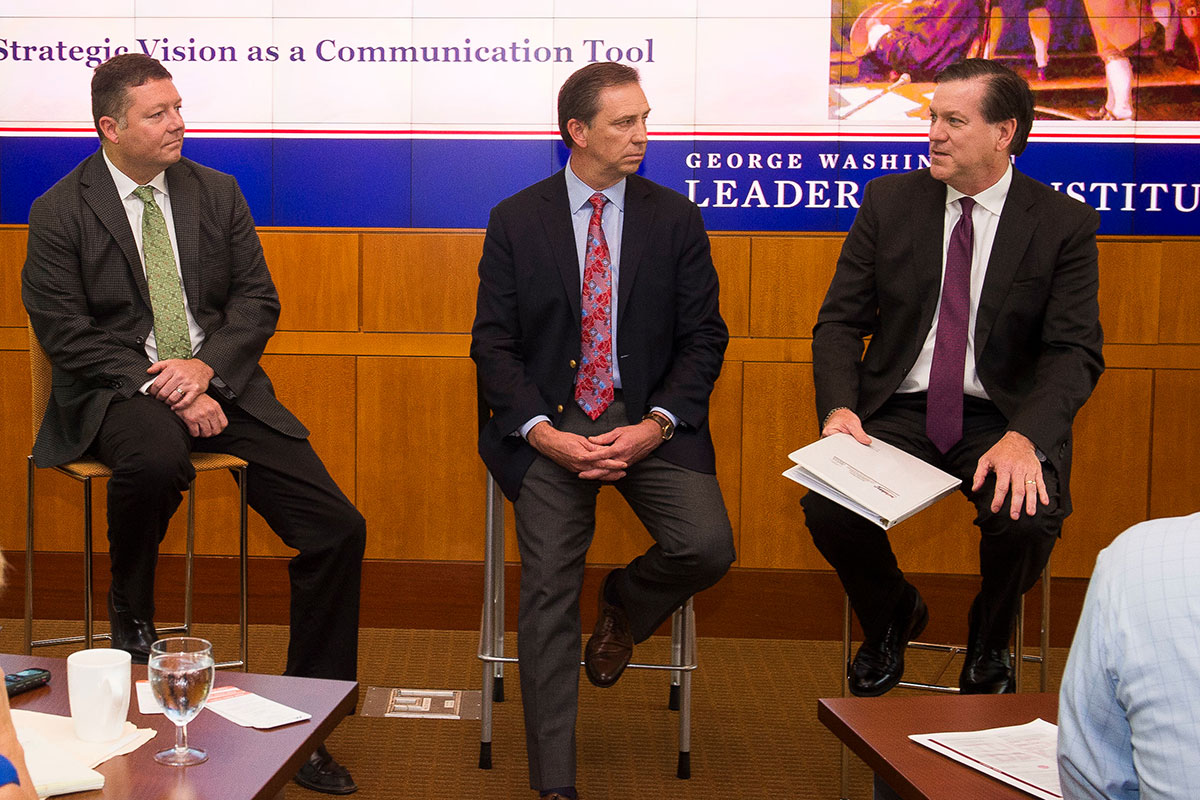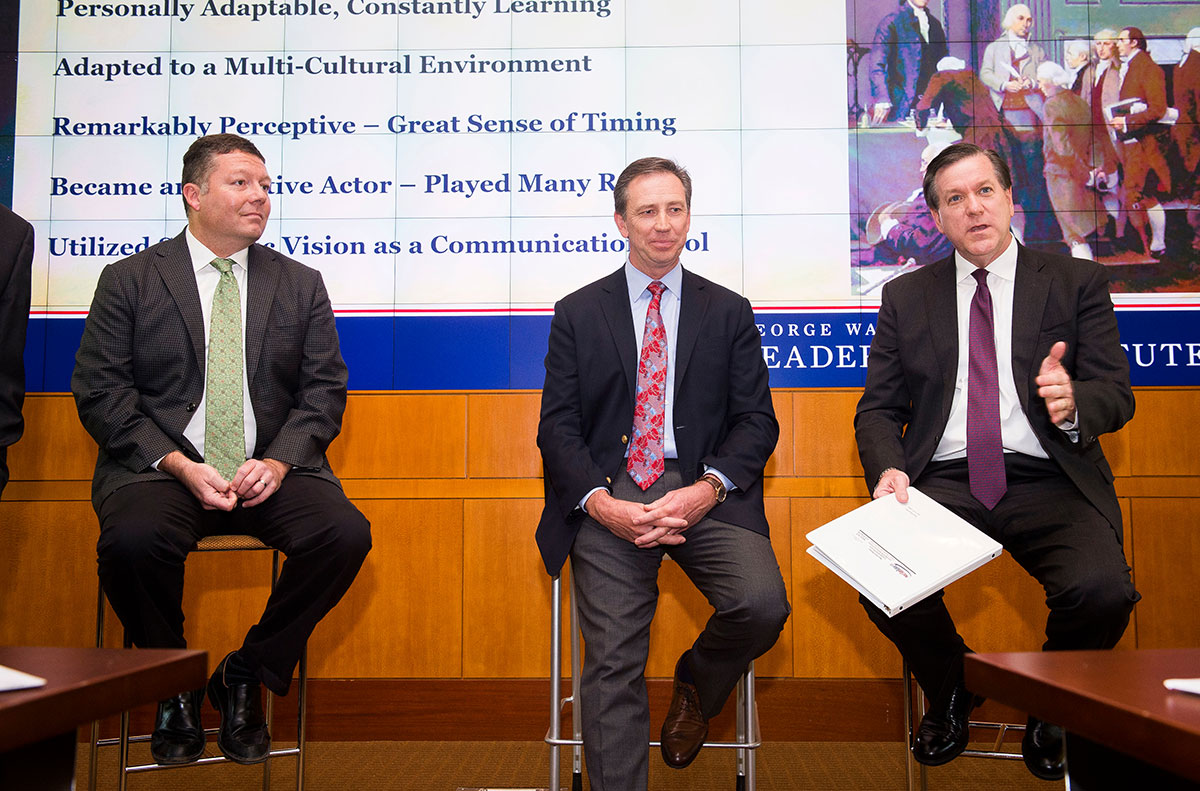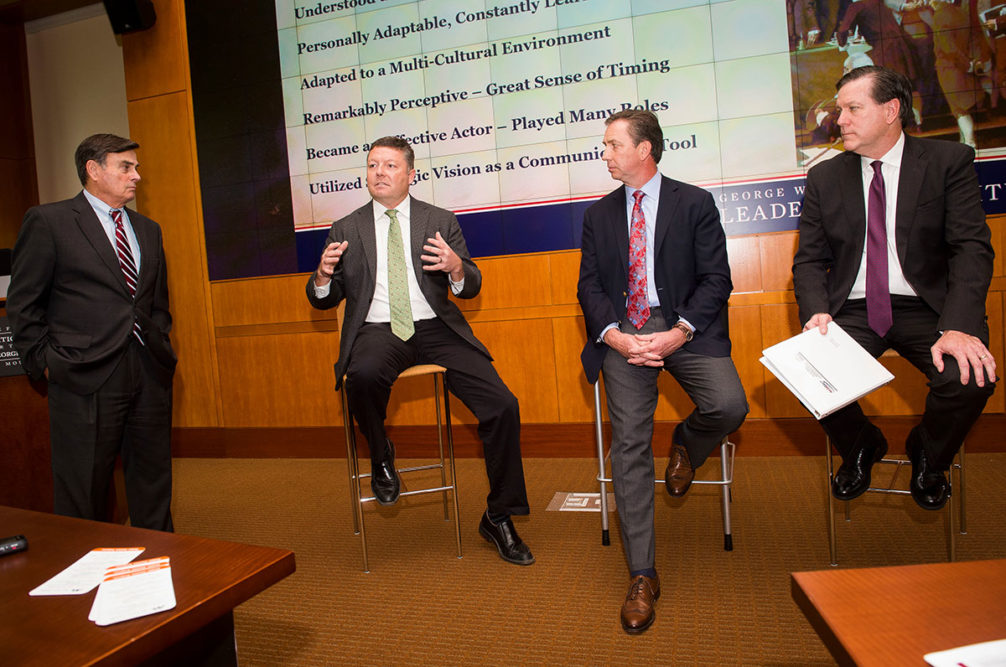MOUNT VERNON, VA. — The American Bakers Association recently looked at leadership through a foundational lens. At the association’s NextGen Baker Leadership Forum, held Oct. 1-2 at the George Washington Leadership Institute at Mount Vernon, Va., and in conjunction with the A.B.A. and A.T.B.I. board of directors meetings, three baking industry veterans joined forces to deliver a few lessons in leadership from the c-suite.
Bradley K. Alexander, president, fresh packaged bread, Flowers Foods, Thomasville, Ga.; Tim Cook, president and chief executive officer, Shick Esteve, Kansas City; and William W. Quigg, president, Richmond Baking Co., Richmond, Ind. (which has a sister company, More Than A Bakery, Versailles, Ky.), shared their thoughts and best practices on leadership, vision and strategic planning in their businesses.
The discussion was based on the leadership principles of the nation’s founding father, President George Washington. Leading the panel was Peter Cressy, Ph.D., retired U.S. Navy Rear Admiral and director of executive leadership management and strategy programs at the George Washington Leadership Institute. In part one of Baking & Snack’s Lessons in Leadership series, the three executives discuss creating company goals and executing ideas on the workplace.
Peter Cressy: How do you ensure that your team stays focused on both short- and long-term goals in areas such as product development, sales goals, safety standards, etc.? How do you keep people focused?
Brad Alexander: What we do at Flowers is set team goals. Everybody knows their goals, and we measure them every week. We meet every Friday and talk about where we are compared to our goals, what adjustments we might need to make — what assumptions are helping or hurting us in our goal setting.
That must emphasize the importance of getting the vision right and getting people to buy in.
Tim Cook: It’s a similar process for us. We don’t review as often; for us, it’s monthly by department and quarterly by company. I think the thing Brad said that’s key is moving from strategic development into strategic deployment. That’s how we refer to it. It’s really a matter of taking the strategy and mapping it out over the course of time. Then, not only do you have your mileposts along the way to check in on, but the whole team also knows what the plan is throughout the year, so they know when they’re on track or off track. And we boil it down to a simple red and green system.

Have you encountered any challenges with getting everyone on board with a new vision, and how do you handle it?
Bill Quigg: That’s a great question because I just instituted a new vision and mission for our company about a year ago. I say “instituted” because I believe — at least in a privately held company such as ours, a family business that’s been around for more than a century — that the company’s vision is actually my vision. I got a little bit of counsel from people, but it was not a consensus, which is very unlike our company culture. But then the mission, strategy and the rest of that was a group effort.
Our vision is, simply, that we are “world-class creators of cookies, crackers, crumbs and smiles.” But from that flowed the mission and value statements. As far as bringing it in for people, I think as much as anything, it’s understanding how we act when we make 10,000 decisions every day. I can put it on the walls all we want; we can make up cards, and it’s all great. For example, I have a vision/mission/values meeting with all family members — that’s our term for employees — so, for all our family members, when they become a full-time member of our family at 90 days, I have a meeting with them, and we talk through vision, mission and values. I ask them, “How are we living up to this? Where are we falling short? How can we do better?”
One of our values is that we lead engaged, balanced and purposeful lives. And I prove that because I give them the rest of the day off to lead an engaged life that they want to lead for that day. It’s a process where I’m making the rubber hit the road.
Mr. Alexander: I was recently involved in a big project to redefine our mission and vision. You think, “Oh, that will take no time.” But every word needs to mean something. Once we put it all together, we had a meeting in Atlanta with our top leaders for a day and a half and walked them through the changes and new mission to make sure everyone understood and could ask questions.
What are the things your executive team has done from time to time to help you achieve success in executing a new vision?
Mr. Cook: When I first came to the company, I instituted what I thought was a brilliant plan for strategic deployment. It was working fine, but a couple years in, at some of our managers’ meetings, they said, “We’re not really sure that we get the full picture from the way this was done. It’s so departmentally focused. We know what we’re working on in our department, but we don’t really know what the other departments are working on, and we don’t necessarily get how it moves us forward as a company, not just as departments.”
So, we switched from a strategic deployment process that was really departmentally task-focused to one where the whole company comes together and decides what the top objectives are for the organization, and we pick people cross-functionally to be on the team to achieve the strategic objective. And I found there was so much more buy-in because they were making it theirs, and we were much more successful.
Have others found this collaboration with vision and moving things forward?
Mr. Alexander: We do. It’s kind of a joke in our office — we have a new building that a lot of us moved into — we have three conference rooms, and one is called Collaboration. One is called Ideation (being creative). And the other one’s called Execution. Most people don’t like being in the Execution room on Friday.
But to be serious about collaboration, we have worked hard to make sure we are communicating clearly about our new structure and the new ways we need to work together. There are people on my team with 20 years or more experience, and those who have just been with us a year. We really work closely with supply chain, manufacturing and purchasing to make sure everyone understands the concept of working cross-functionally. What I try to do is give new people a project where they can learn a lot about the company as part of the process. They have to reach out to other departments to see how they tie-in and what they bring to the table. It’s a great way to understand how every department, every team is intertwined. We can only be successful if all the parts work in unison.

How do you handle it when you, at the top, flat-out disagree with where the group thinks you need to go? Any examples of where collaboration led to an important compromise that worked?
Mr. Cook: Certainly, my view is that you have to allow room for mistakes. As a leader, I think one of the most valuable things I can do for our team is have conversations about the challenges facing the business and perhaps even propose what I think are some solutions.
I always turn it back on our leaders. I say, “You tell me how you think we should handle this situation and what you believe the outcome will be.” And if they’re passionate about the way they want to handle something, more often than not, I will give them the freedom. I think greater than whatever the particular issue is, is the lesson that will come out of it — for me or for them.
It’s about giving freedom. To me, those are the best coaching opportunities, as well. I have found that when I am willing to compromise, people engage and own the process.
This is interesting: the use of data to develop an appropriate collaboration or compromise in moving the company forward. George Washington recorded everything … he was very serious about it. Has anyone else had experience in coming to a compromise or developing a way ahead by getting new data?
Mr. Alexander: We love data … probably a little too much sometimes. But the critical thing is making sure that our teams have the data they need to support their idea or solution. It’s not about just relying on your gut feeling.
I agree with Tim. Sometimes, if people are passionate, and you push back and they keep coming, you’ve got to just let them do it. And many times, they’ll prove you wrong. We’re not always right.
Mr. Quigg: You mentioned sometimes we have too much data. I think one thing we fall into the trap of is that data is very expensive to gather. That shouldn’t be forgotten. It’s time; it’s resources; it’s analysis. My caution is that I absolutely want to gather as much data as is practical, but not possible. If it’s not the right data, you need to shift that quickly because you could spend a lot of time on research.





